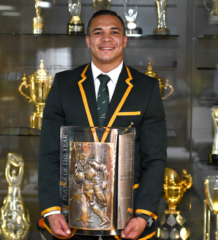SANZAAR responds to stakeholder feedback to re-boot Vodacom Super Rugby
SANZAAR announced on Sunday that Vodacom Super Rugby had been restructured for 2018 and would kick-off with a three conference, 15-team format featuring four teams from South Africa, five from New Zealand, four from Australia, one from Japan and one from Argentina.
The streamlining of the competition comes at the end of a nine-month consultation and strategic review process that looked at the short and long-term prospects for SANZAAR’s competitions.
The decision to reduce Vodacom Super Rugby competitors by three teams was unanimously agreed by the four SANZAAR partners. Franchises, broadcasters and fans were all engaged in the process.
“Fans, media and broadcasters have spoken and we have listened to them,” said Jurie Roux, CEO of SA Rugby. “The 18-team Vodacom Super Rugby competition has not worked and we had to face up to that hard fact. The integrity of the format and the lack of competitiveness in too many matches were major issues that needed addressing.
“From a South African rugby high performance perspective we’ve had to acknowledge that the dilution of talent and resources across six franchises – at a time when rand weakness has led to more departures to Europe and Japan – has seriously affected our ability to compete across the board.
“As a rugby nation we need several strong franchises all of whom are in with a serious chance of challenging for the title and we could no longer say that. A reduction in the number of South African franchises was the unavoidable conclusion, especially when put in the context of SANZAAR’s long-term strategy of adding to our tournaments’ appeal and commercial success which, in time, will mean greater returns for SA Rugby.”
SA Rugby will now begin internal consultations to identify its four entrants to the 2018 competition.
The newly-established Franchise Rugby Committee (made up of representatives of all six teams) will meet on Tuesday to finalise the criteria for selection. Their recommendation will go to the Executive Council. Once that recommendation is agreed it will need to be approved by the General Council of SA Rugby.
SANZAAR Chairman, Brent Impey said: “The decision to revert to a 15-team format reflects a consensus view of the mandated SANZAAR Executive Committee that met in London recently. It was not the determination of any one Union or stakeholder and follows a thorough assessment and review of the tournament over the last nine months.
“SANZAAR is delighted that its major broadcast partners have after due consideration agreed to the restructured format within the existing broadcast agreements. Our broadcaster partners are an important stakeholder and their vision for Super Rugby moving forward is the same as ours.
“This decision has not been an easy one and we recognise the difficulty associated with reducing the number of teams in Australia and South Africa. Naturally we understand that there will be some very disappointed franchises but the tournament’s long-term future and the economic reality of the business at present is something that had to be addressed.
“The decision to retain the Sunwolves is linked directly to SANZAAR’s strategic plan for the future. The potential for growth of the sport in Asia off the back of the establishment of the Sunwolves and the impending RWC in 2019 is significant. It remains an obvious focus for the organisation and a Japanese Super Rugby franchise is key to that strategy.”
Roux admitted a reduction in teams was a bitter pill for South Africa to swallow but his organisation had faced up to the fact that retaining six teams would have put South African rugby at an even greater risk.
“We have six strategic imperatives for 2017 – two of the most critical of which are Springbok performance and financial sustainability,” he said.
“Retaining a number of under-performing teams in Vodacom Super Rugby makes no sense from a high performance or financial point of view. We no longer have the resources to support them to the required level.”
Roux said the large number of South Africans now playing overseas had hastened the decision: “There are about five or six Vodacom Super Rugby squads’ worth of South Africans playing overseas.
“In 2015, 257 South Africans appeared for leading teams overseas; last year it was 313 – including 65 Springboks. There were eight Van der Merwes, seven Du Preez’s and six Du Plessis’s alone! That has got to have had an impact on our competitiveness.”
The new format will see the Sunwolves move into the Australian Conference while the South African conference will continue to feature the Jaguares.
The winners of each conference plus another five teams with the greatest number of log points will qualify for the play-offs.
SA franchises will play teams from both the Australian and New Zealand conference every year although the duration of the available ‘window’ – between the end of the compulsory rest period and the start of the international season – means that there are not enough weeks to play all teams.
Tournament Format
- 120 match regular season plus seven finals
- 15 teams
- Three conferences
- 18 rounds [16 matches per team, two bye weeks]
- Each team will play eight matches within its conference (four home and four away)
- Each team will play eight cross-conference matches – against four of the five teams from the other two conferences (four at home and four away)
- Each team will have played 12 of the other teams within the season (85% which is up from 70% in 2016).
- Eight team Finals Series: Three Conference winners and five wild card places – the next best performing teams after the Conference winners regardless of Conference.
SA Rugby said that it hoped it would be able to confirm its 2018 Vodacom Super Rugby participants by the end of June.
Related Posts
« Blitzboks still in hunt for Hong Kong glory Kolisi leads DHL Stormers to dazzling victory – Vodacom Super Rugby Round 7 Roundup »

















